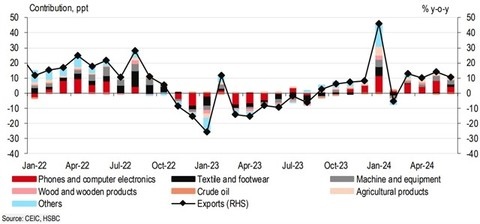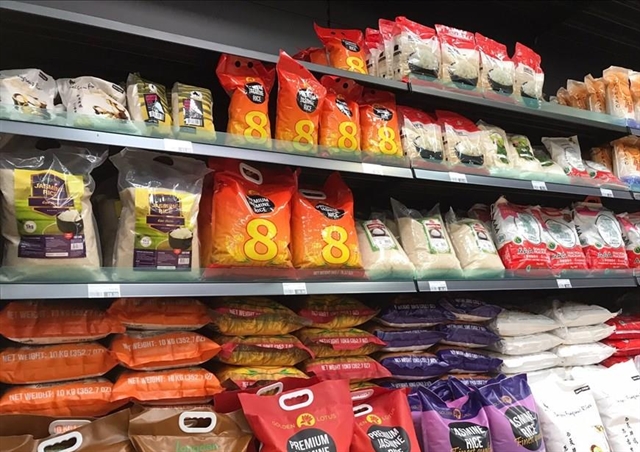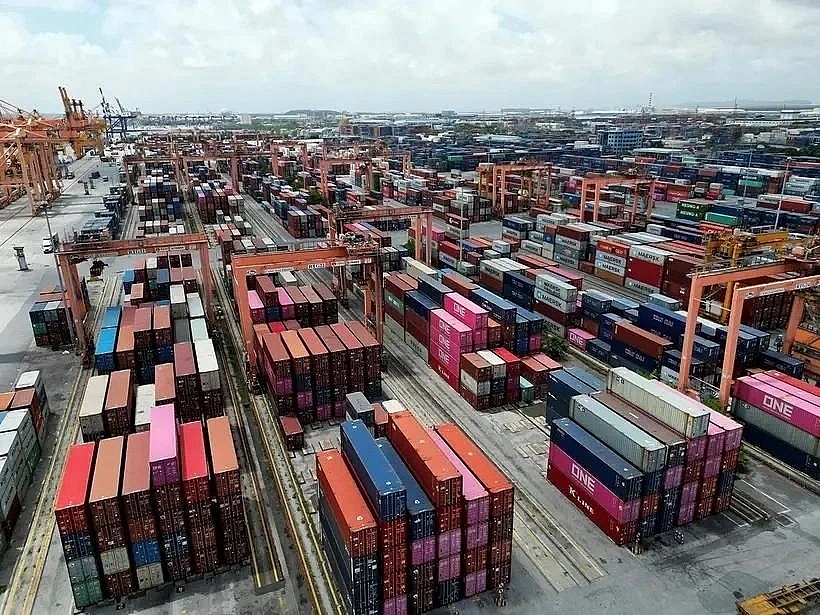Việt Nam brings it all back: HSBC
Việt Nam brings it all back: HSBC
Việt Nam is likely to be the fastest-growing economy in ASEAN in 2024, a spot it lost to Malaysia and the Philippines in 2022 and 2023, respectively, according to a report released by HSBC’s economists on July 24.

Việt Nam’s export recovery is still led by electronics, but starting to broaden. — Photo courtesy of the bank |
They said Việt Nam remains on track to see brighter growth prospects in 2024, if the recovery continues to broaden out. Given the better-than-expected growth in the second quarter 2024, they predict that the country’s yearly GDP growth will be 6.5 per cent, previously 6 per cent.
That said, how sustained the trade recovery is and how quickly it will be broadened out to domestic sector are factors that warrant close watch.
According to the economists, Việt Nam ended second quarter this year with a massive upside surprise to its GDP growth, which accelerated to 6.9 per cent year-on-year, well above market expectations of 6 per cent. Beyond headline numbers, its recovery has started to show signs of broadening out.
For trade, the tech recovery continues to fuel the much-needed steam while other sectors have also bottomed out to return to decent growth. Meanwhile, tourism-related services continue to shine, after Việt Nam welcomed more than 8.8 million tourists in the first quarter 2024. That said, recovery in domestic sectors continues to lag behind the external-facing ones, which the economists expect to continue to happen in the fourth quarter 2024.
The biggest upside surprise to those compiling the report came from the manufacturing sector, which expanded 10 per cent year-on-year. This is also reflected in strong growth in the second quarter exports of 15 per cent year-on-year.
“We have been flagging an uneven recovery in its trade sector, which has been predominantly led by the electronics recovery. While the trend continues to hold, non-electronics shipments have started to show green shoots. In particular, exports of textiles and footwear, which are more exposed to the Red Sea disruptions, also bounced back to see double-digit growth in the second quarter.” the report said.
Outside of trade, tourism-related services continue to sustain the positive momentum. This also explains why sectors including transport and accommodation have continued to shine. Halfway through 2024, Việt Nam attracted more than 8.8 million tourists, exceeding its 2019 levels. In particular, even without a visa-free scheme, the return of Chinese tourists approached 80 per cent in the equivalent period. While Việt Nam is on track to reach its annual goal of welcoming 17-18 million tourists in 2024, they say there is still see room for further improvement, including an expansion in the visa exemption list.

Việt Nam leads the region in attracting tourists in 2024. — Photo courtesy of HSBC |
In terms of inflation, the headline rate rose 0.2 per cent month-on-month in June, translating into still-high year-on-year figure of 4.3. While monthly oil prices dropped, this fall was more than offset by a rise in pork prices, due to the ongoing African swine fever (ASF) since early this year.
The Ministry of Agriculture and Rural Development (MARD) has urged four provinces to combat ASF, as the disease has resulted in the culling of almost ten thousand pigs, equivalent to 40 per cent of the national total. In the past, volatility in pork prices pushed up inflation sharply, solidly breaching its inflation target. That said, barring a deterioration of ASF that might impact the supply of pork, inflation has likely peaked, report the analysts. When favourable base effects kick in 2H24, they forecast inflation to moderate to a little above three per cent on average in 2H24, likely bringing average inflation to 3.6 per cent.
“Given the better-than-expected outturns in the first quarter this year, we are upgrading our yearly GDP growth forecast to 6.5 per cent for 2024. This will likely put Việt Nam back to the position of ASEAN’s fastest-growing economy, a spot it lost to regional peers in the past two years. We also recently trimmed our 2024 inflation forecast to 3.6 per cent,” concluded the report.



























